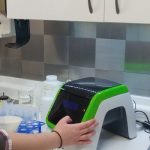MANTECH’s case study can be found here: PeCOD Monitoring for Disinfection Byproduct Formation: Case Study
Toxic and carcinogenic compounds are produced when phenols in drinking water mix with chlorine, the most common chemical used to disinfect drinking water in the U.S.
Chlorine, the most common chemical used to disinfect drinking water in the United States, creates previously unidentified toxic byproducts in the very water its meant to disinfect, according to a new study from researchers at Johns Hopkins and the University of California, Berkeley, as well as in Switzerland.
The researchers’ findings were recently published in the journal Environmental Science & Technology.
“There’s no doubt that chlorine is beneficial; chlorination has saved millions of lives worldwide from diseases such as typhoid and cholera since its arrival in the early 20th century,” says Carsten Prasse, an assistant professor of Environmental Health and Engineering at Johns Hopkins and the paper’s lead author. “But that process of killing potentially fatal bacteria and viruses comes with unintended consequences. The discovery of these previously unknown, highly toxic byproducts raises the question of how much chlorination is really necessary.”
Phenols, chemical compounds that occur naturally in the environment and are abundant in personal care products and pharmaceuticals, are also commonly found in drinking water. When these phenols mix with chlorine, the process creates a large number of byproducts. Current analytical chemistry methods, however, are unable to detect and identify all of these byproducts, some which may be harmful and can cause long-term health consequences, says Prasse.
For the study, Prasse and his collaborators added N-α-acetyl-lysine, which is almost identical to the amino acid lysine that makes up many proteins in our bodies, to detect reactive electrophiles, harmful compounds which have been linked to a variety of diseases. The technique of identifying compounds based on their reaction with biomolecules like DNA and proteins is commonly used in the field of toxicology.
The researchers first chlorinated water using commercial methods: they added excess chlorine, which ensures sufficient disinfection but also eliminates harmless smell and taste compounds that consumers often complain about. Then the team added the aforementioned amino acid, let the water incubate for one day, and used mass spectrometry, a method of analyzing chemicals, to detect the electrophiles that reacted with the amino acid.
Click here to read the full article: Common Water Disinfecting Method May Result In Toxic Byproducts, Study Finds







